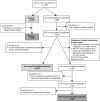The international, prospective Glanzmann Thrombasthenia Registry: treatment modalities and outcomes of non-surgical bleeding episodes in patients with Glanzmann thrombasthenia
- PMID: 26001793
- PMCID: PMC5004418
- DOI: 10.3324/haematol.2014.121475
The international, prospective Glanzmann Thrombasthenia Registry: treatment modalities and outcomes of non-surgical bleeding episodes in patients with Glanzmann thrombasthenia
Abstract
Standard treatment for Glanzmann thrombasthenia is platelet transfusion. Recombinant activated factor VII has been shown to be successful in patients with Glanzmann thrombasthenia with platelet antibodies or who are refractory to platelet transfusions. The Glanzmann Thrombasthenia Registry prospectively collected worldwide information on the effectiveness and safety of platelet transfusion, recombinant activated factor VII and/or antifibrinolytics for the treatment of bleeds in patients with Glanzmann thrombasthenia. Data relating to 829 non-surgical bleeding episodes were entered into the Glanzmann Thrombasthenia Registry (severe/moderate: 216/613; spontaneous/post-traumatic: 630/199). Recombinant activated factor VII alone was used in 124/829 bleeds, recombinant activated factor VII+antifibrinolytics in 107/829, platelets±antifibrinolytics in 312/829, antifibrinolytics alone in 219/829, and recombinant activated factor VII+platelets±antifibrinolytics in 67/829. The proportion of successful treatments to stop bleeding was 91.0% in cases treated with recombinant activated factor VII only, 82.7% for recombinant activated factor VII+antifibrinolytics, 72.7% for treatment with recombinant activated factor VII+platelets±antifibrinolytics, 78.8% for platelets±antifibrinolytics and 84.7% for antifibrinolytics alone. Treatment failure was documented in 18 bleeding events (2% of the total treatments), the majority of which were in patients receiving treatment with antifibrinolytics; bleeding re-started in 6% of bleeds after initial effective treatment. Thirty-five adverse events were reported, none of which was a thromboembolic event. Among treatments that included recombinant activated factor VII, only one patient reported three possibly drug-related non-serious adverse events (nausea, dyspnea and headache). To conclude, non-surgical bleeds were common and often severe in Glanzmann thrombasthenia; both platelets and recombinant activated factor VII appeared to be effective, and with good safety profiles, for the treatment of non-surgical bleeds. This trial was registered at clinicaltrials.gov identifier: NCT01476423.
Copyright© Ferrata Storti Foundation.
Figures

References
-
- Caen JP, Castaldi PA, Leclerc JC, et al. Congenital bleeding disorders with long bleeding time and normal platelet count. 1. Glanzmann’s thrombasthenia (report of fifteen patients). Am J Med. 1966;41(1):4–26.
-
- George JN, Caen JP, Nurden AT. Glanzmann’s thrombasthenia: the spectrum of clinical disease. Blood. 1990;75(7):1383–1395. - PubMed
-
- Nurden AT, Caen JP. An abnormal platelet glycoprotein pattern in three cases of Glanzmann’s thrombasthenia. Br J Haematol. 1974;28(2):253–260. - PubMed
-
- Nurden AT. Inherited abnormalities of platelets. Thromb Haemost. 1999;82(2):468–480. - PubMed
-
- Reichert N, Seligsohn U, Ramot B. Clinical and genetic aspects of Glanzmann’s thrombasthenia in Israel: report of 22 cases. Thromb Diath Haemorrh. 1975;34(3):806–820. - PubMed
Publication types
MeSH terms
Substances
Associated data
LinkOut - more resources
Full Text Sources
Other Literature Sources
Medical

